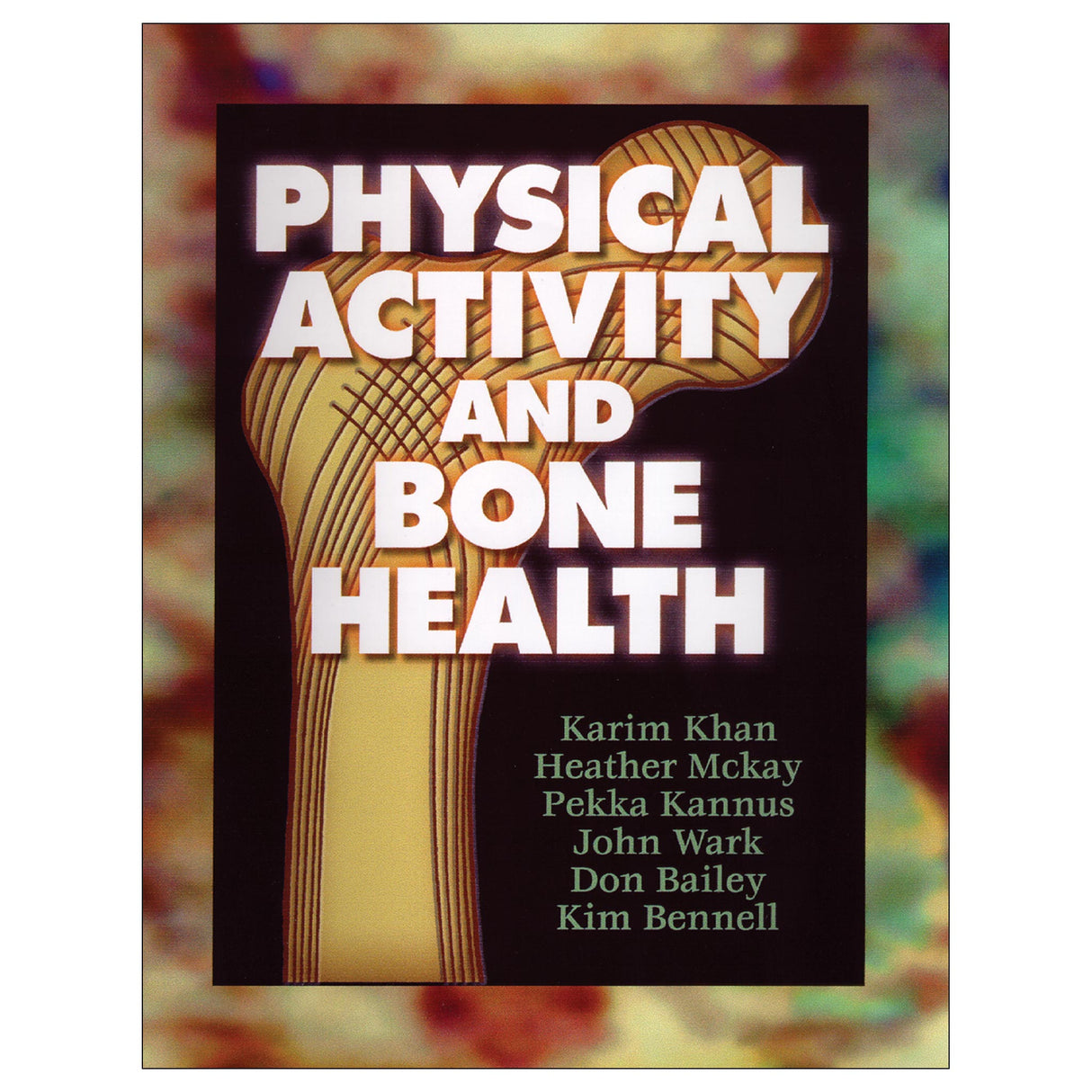Physical Activity and Bone Health
$49.00 CAD
As an increasing amount of research on mechanical loading, exercise, and bone health becomes available, there is a growing need to synthesize and clarify the rapidly evolving information. No other resource fills this need better than the timely Physical Activity and Bone Health—the first book of its kind to examine effective exercise as it contributes to bone health.
This text is written for all “students” of the human movement sciences with an interest in skeletal structure and function. It compiles a wealth of research literature—from the earliest to the most recent studies—making it a time-saving and essential resource.
Physical Activity and Bone Health was written by six highly acclaimed authorities in the field, which adds tremendously to its value. Only in this book will you gain access to such broad and balanced perspectives and a diverse knowledge base.
Emphasizing exercise and its effect on bone, the book's sections–which can be read in any order–contain current information on these topics:
- Basic anatomy and physiology of the structure and function of bone
- Factors other than exercise that influence bone
- Exercising to maintain a healthy skeleton from childhood through old age
- The role of exercise in preventing perimenopausal bone loss
- Medical issues of bone deterioration
- Questions that require further research
In addition, one section of the book is devoted to practical exercise prescriptions for different stages of life—from childhood and adolescence to adulthood and the elderly years. The exercise prescriptions are safe and effective and can be used by professionals in physical activity, health, and bone fields as a way to optimize bone health.
Physical Activity and Bone Health is richly supported with illustrations, more than 850 references, and 20 chapters that stand alone or can be read together for a comprehensive picture.
For those who wish to explore the frontiers of bone health, Physical Activity and Bone Health is a handy and trusted guide.
Audience
Reference for sports medicine physicians, orthopedic surgeons, geriatricians, general practitioners, physical therapists, athletic trainers, exercise scientists, students, and others interested in improving bone health through physical activity.
Part I. Structure, Function, and Measurement of Bone
Chapter 1. Anatomy
Bone's Organic Makeup
Macroscopic and Microscopic Appearance
Bone Cells: Osteoblasts, Osteocytes, Osteoclasts
Summary
References
Chapter 2. Physiology
Calcium Homeostasis
Mechanotransduction
Modeling and Remodeling
Summary
References
Chapter 3. Biomechanics
Material Properties of Bone
Structural Properties of Bone
Bone's Response to Local Mechanical Loading
How Physical Activity Generates Loads on Bone
Summary
References
Chapter 4. Measuring the Properties of Bone
Dual Energy X-Ray Absorptiometry
Quantitative Ultrasound
Quantitative Computed Tomography
Measuring Bone Metabolism: Biochemical Markers
Summary
References
Part II. Determinants of Bone Mineral Other Than Physical Activity
Chapter 5. Age, Sex, Genetics, and Race
Age
Sex
Genetics
Race and Ethnicity
Summary
References
Chapter 6. Soft Tissue Determinants of Bone Mineral Density
Total Body Mass and BMD
Lean Mass and BMD
Fat Mass and BMD
Soft Tissue in Bone Research Studies
Summary
References
Chapter 7. Influence of Normal Endocrine Function on Bone Mineral
Estrogen
Progesterone
Effects of Pregnancy and Lactation
Testosterone
Growth Hormone and Insulin-Like Growth Factor I
Corticosteroid Hormones
Thyroid Hormone
Summary
References
Chapter 8. Dietary Intake and Bone Mineral
Calcium Intake and Bone Mineral Density at Various Life Stages
Vitamin D and Bone Mineralization
Dietary Supplementation and Fracture Risk
Interaction of Calcium and Physical Activity
Other Lifestyle Factors and Bone Mineral Density
Summary
References
Part III. Evidence and Prescription: A Life Span Approach
Chapter 9. Measurement of Physical Activity
Inherent Limitations
Traditional Methods
Suggestions for Measuring Physical Activity in Bone Studies
Summary
References
Chapter 10. Physical Activity and Bone in Childhood and Adolescence
Exercise, Bone Mineral Response, and Age
Normal Bone Mineral Accrual
Targeted Bone Loading and Bone Mineral
Generalized Physical Activity and Bone Mineral
Exercise Prescriptions
Summary
References
Chapter 11. Physical Activity, Targeted Bone Loading, and Bone Mineral in Premenopausal Women
Longitudinal Studies: Exercise Intervention
Cross-Sectional Studies: Athletes Versus Controls
Longitudinal Studies: Athletes Versus Controls
Cross-Sectional Studies: Generalized Physical Activity
Mechanism of Bone Augmentation
Exercise Prescription
Summary
References
Chapter 12. Physical Activity, Targeted Bone Loading, and Bone Mineral in Postmenopausal Women
Vertebral BMD and Targeted Bone Loading
Vertebral BMD and Minimal Bone Loading
Proximal Femoral BMD and Targeted Bone Loading
Mechanism of Bone Changes
Mechanism of Mechanical Load Adaptation
Exercise Prescription
Summary
References
Chapter 13. Physical Activity and Bone Mineral in Men
Controlled Trials of Exercise and BMD
Longitudinal Observational Studies
Cross-Sectional Studies of Athletes and Controls
Studies Examining Physical Activity As a Determinant of BMD
Mechanism of Bone Gain
Exercise Prescriptions
Summary
References
Chapter 14. Exercise and Fall Prevention
Falling, Fracture, and Age-Related Physiological Changes Among Older Adults
Can Exercise Decrease the Incidence of Falls?
Guidelines for Exercise Prescription
Summary
References
Chapter 15. Exercise Prescription for People With Osteoporosis
The Problem of Osteoporosis
Finer Point: Commonly Prescribed Treatments for Osteoporosis
Exercise Prescriptions
Summary
References
Part IV. Intense Physical Activity and Bone Health
Chapter 16. Skeletal Effects of Menstrual Disturbance
Delayed Menarche and Bone Mass
Intense Physical Training and Linear Growth
Menstrual Disturbance and Bone
Other Factors Contributing to Osteopenia
Athlete Menstrual Disturbance and Osteoporosis
Mechanism of Bone Loss
Treatment of Amenorrheic Women
References
Chapter 17. Stress Fractures
Continuum of Bone Overuse Injury
Why Stress Fractures Occur—Pathophysiology
Clinical Aspects
Treatment of Stress Fractures
Risk Factors
Summary
References
Part V. Research Opportunities: Physical Activity and Bone Health
Chapter 18. Getting Involved in Bone Research
Studies: Bone at the Molecular, Cellular, and Tissue Levels
Summary
References
Chapter 19. Research Projects Suitable for a Master's Thesis Course Work
Studies Appropriate for a Master's Thesis
Summary
References
Chapter 20. Research Projects Suitable for a PhD Thesis
Recent Bone and Physical Activity Doctoral Theses
Current Questions in the Field
Summary
References
Appendix A. Tables
Appendix B. Questionnaires





